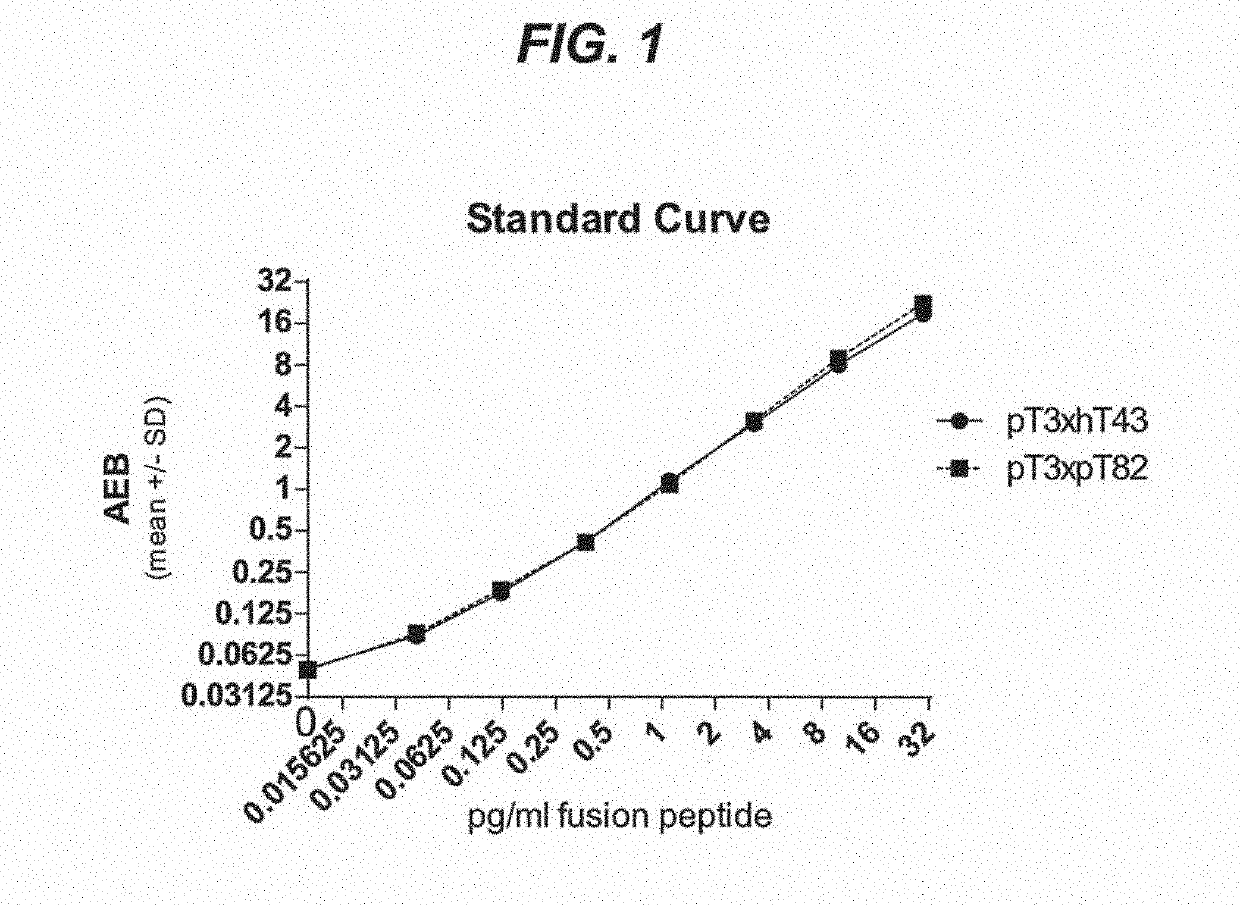Assays to detect neurodegeneration
a technology of neurodegeneration and assays, applied in the field of compositions and methods for detecting neurodegeneration, can solve problems such as affecting the primary function of tau, affecting the translation of this idea, and presenting a major present and future public health problem
- Summary
- Abstract
- Description
- Claims
- Application Information
AI Technical Summary
Benefits of technology
Problems solved by technology
Method used
Image
Examples
example 1
itivity Assay for Detecting p217+ Tau
[0219]Assay-specific reagents were as follows: Simoa Homebrew kit (Quanterix, cat#101351), Helper beads (Quanterix, cat#101732), pT3 mouse monoclonal antibody (mAb), hT43 mAb, pT82 mAb and hT7 mAb. pT3 is the parental antibody developed at Janssen that recognizes p217+ tau, and the humanized version thereof is referred to herein as humanized pT3 mAb.
[0220]The samples were diluted in 50 mM Tris, 50 mM NaCl, 5 mM EDTA, 2% Bovine Serum Albumin, 0.1% Tween 20, 0.05% ProClin 300, pH7.8.
[0221]Three custom peptides made by New England Peptide were used to calibrate the assay (calibrant peptides).
[0222]Peptide pT3xhT43 contains hT43, PT51 and pT3 epitopes connected by PEG4 linkers and has a molecular weight of 6893 g / mol. The amino acid sequence of peptide pT3xhT43 is PRQEFEVMEDHAGTYGLGDR(dPEG4)GKTKIATPRGAAPPGQKG(dPEG4)GSRSR(pT)PS LP(pT)PPTREPKKV-amide (SEQ ID NO: 22).
[0223]Peptide pT3xpT82 contains pT82 and pT3 epitopes connected by a PEG4 linker and ha...
example 2
n of Native Tau Fragments on rpHPLC
[0232]Reagents were as follows: Trifluoracetic acid (HPLC grade), Water (HPLC grade), Acetonitrile (HPLC grade), Phosphoric acid (analytical grade), and HPLC binary gradient system, Immunoassay Buffer (100 mM TrisHCl, 100 mM NaCl, 0.05% Tween, & BSA, pH7.8).
[0233]The protocol was as follows: 500 ul of frozen CSF was thawed on ice for 30 min. The thawed CSF was added to 1.5 ml of 100 mM sodium phosphate pH 2.5 containing 100 mM sodium chloride and mixed. 1.8 ml of the resulting mixture was applied onto a C18 or similar reverse phase chromatography column equilibrated in 0.1% trifluoracetic acid in water. The HPLC column was then developed in an increasing gradient of acetonitrile. Fractions were collected across the elution. The fractions were adjusted to 10 mM in guanidine HCl and then dried in a vacuum concentrator. The dried fractions were resuspended in immunoassay buffer and subjected to measurement of the tau peptide in the fraction based on a...
example 3
ation of P217+ Tau that is Free or Bound by Antibodies
[0234]With additional upstream sample manipulation, the high sensitivity pT3-based assays can be used to measure the binding of p217+ tau by antibodies that are either produced within a patient or are administered exogenously, e.g. humanized pT3 mAb. This technique can be used as a pharmacodynamic assay to study therapeutic anti-p217+ tau antibodies such as humanized pT3 mAb. For example, the following methods can be used to measure p217+ tau that is antibody-free vs. antibody-bound.
[0235]Assay 1: Quantification of Free Vs. Bound p217+ Tau in Biological Fluids Using Immunocapture / Depletion Followed by rpHPLC
[0236]Biological fluid (e.g. CSF) was incubated with protein A / G-coated magnetic beads (15 μl bead slurry per 0.5 mL CSF) for 2 hrs with rocking at room temperature to capture immunoglobulins in the sample. Beads were precipitated by magnet and the supernatant was transferred to second tube (sample=“IgG depleted supernatant”)....
PUM
| Property | Measurement | Unit |
|---|---|---|
| dissociation constant | aaaaa | aaaaa |
| dissociation constant | aaaaa | aaaaa |
| dissociation constant | aaaaa | aaaaa |
Abstract
Description
Claims
Application Information
 Login to View More
Login to View More - R&D
- Intellectual Property
- Life Sciences
- Materials
- Tech Scout
- Unparalleled Data Quality
- Higher Quality Content
- 60% Fewer Hallucinations
Browse by: Latest US Patents, China's latest patents, Technical Efficacy Thesaurus, Application Domain, Technology Topic, Popular Technical Reports.
© 2025 PatSnap. All rights reserved.Legal|Privacy policy|Modern Slavery Act Transparency Statement|Sitemap|About US| Contact US: help@patsnap.com



